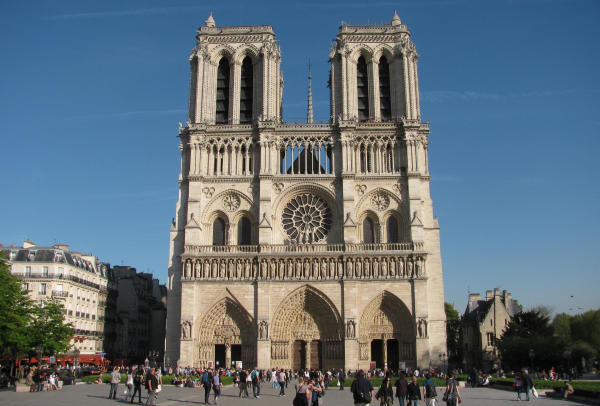
We stood across the square from Notre-Dame. There it was, the western façade of the cathedral, the three doors, the row of kings, the rose window, the two towers, a peek at the steeple.
Susan took a deep breath and left her mouth open. She was in ecstasy.
“Look, Claire,” she said to her daughter. “It’s beautiful. So beautiful. What do you think Claire? Notre-Dame!”
“I think it’s ugly,” said Claire.
“Don’t say that,” said Susan. “It’s magnificent. It’s Notre-Dame.”
“Well I think it’s ugly.” Claire was 14. Her thick, brown hair fell untamed over her shoulders.
Susan gave me the wink of an accomplice. I was their guide. I turned to the cathedral and pretended to be in deep thought.
“Gary’s going to tell us about it and you’ll see that it’s beautiful,” said Susan. “First, can you take our picture, Gary?”
She handed me her phone. An American offered to take a picture of the three of us and I thanked him, no. Susan put her arm around Claire’s shoulder. She wore a studied expression of joy while Claire gave a cheesy get-this-over-with smile. I took a vertical shot, a horizontal shot, then another shot while crouching down.
I handed Susan her phone. She checked the pictures to see if she looked alright. She was well and simply put together. Her fine brown hair was pulled into a loose pony tail.
“Now tell us why Notre-Dame is so beautiful,” said Susan.
I’d liked Susan from the start. She was easy-going and enthusiastic though so concerned that Claire enjoy herself on this mother-daughter trip that Claire had no choice but to show that she wasn’t.
“I never said it was beautiful,” I said.
“See,” said Claire.
“He’s kidding,” said Susan. “Tell us about Notre-Dame.”
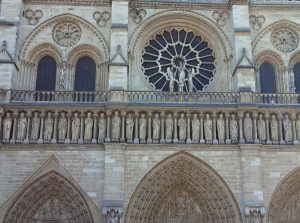 “I’ll tell you what,” I said, “I’ll agree with whichever one of you gives me the best argument for her point of view. Susan, you tell me why it’s beautiful and Claire you’ll tell me why it’s ugly. Susan, you go first.”
“I’ll tell you what,” I said, “I’ll agree with whichever one of you gives me the best argument for her point of view. Susan, you tell me why it’s beautiful and Claire you’ll tell me why it’s ugly. Susan, you go first.”
“OK,” said Susan. “I’m game.” She took a deep breath, thought, opened her arms to Our Lady, then spoke. “Well just look at it… This fabulous view across the square – in the middle of Paris. It’s magnificent. It’s so old. It’s famous. All that stone work. The two perfect towers. It’s so … symmetrical. It’s Notre-Dame. It’s beautiful.” She beams and winked at me again as though she’d pushed all the right buttons.
“Claire? Your turn.”
Lucky for me Claire played the contrarian teen without entirely fitting the role. She may have contradicted her mother at every turn but she had the intellect to back up her contradictions.
“Ugly,” she stated. “It’s just standing there. Or sitting there. Too much going on. A blob of stone. Maybe not a blob but too… messy. Looks like a drawing by a kid who’s trying to fill in every inch of the page. OK, a kid drawing with a ruler, I’ll give you that. But then all this stuff going on everywhere. Is that big circle a window?”
“Yeh.”
“It’s black. Looks like a fat cyclops sitting on the toilet with his hands in the air. Ugly.”
“Oh, Claire,” said her mother.
“Why would he be sitting on the toilet with his hands in the air?” I asked.
“That’s what cyclopses did back them,” answered Claire.
They both looked at me.
“Good reasoning,” I said. “I’m throwing my vote with Claire.”
Claire beamed at her mother.
“He’s joking,” said Susan.
“Are we going inside?” asked Claire.
“If you want?”
“I thought that’s why we were here.”
“Well, if it’s that ugly we don’t have to go in.”
“It’s not that ugly. It’s just ugly. Interesting ugly,” she said. “Definitely not beautiful.”
As we approached the cathedral I explained that when Notre-Dame was built this huge, empty square and wide view didn’t exist. There was just a road – you can see where it was from the cobblestones – leading to a small square in front of the church, otherwise there were other buildings, mostly apartment buildings separated by alleyways, filling the square. I explained that the cathedral we were looking at was only the latest of a succession of religious buildings on or near this site, dating back at least to a temple to the Roman god Jupiter built during the Roman development of a city that they called Lutetia 2000 years ago. That temple would later be rebuilt as a Christian basilica, right about where we were then standing as we got closer. It also served as the cathedral, meaning the seat of the bishop, of Paris. That cathedral, Saint Stephen, was rebuilt and evolved over time until a certain Bishop Sully decided in the year 1163 that Paris as the capital of a powerful Christian kingdom and he the bishop in an increasingly dense, vital, rich and intellectually active city, needed a new, larger, more impressive cathedral built with the latest technology, a technology and an artistic area that came to be called Gothic. And so began the construction of what was now standing, or sitting, before us began.
“And walà,” said Susan, “more impressive and more beautiful.”
“Is this the main church of France?” asked Claire.
“No, a cathedral is the main church in a city or region. It’s the church or seat of a bishop. There are over a hundred Catholic cathedrals in France, each with a bishop. But the true cathedral, rather, temple of France, of the French Republic, is something called the Pantheon. We’re going there next.”
“Is it just as ugly?” she said, elbowing her mother.
“No, different ugly. I think you’ll like it. You’ll both like it. But let’s focus on Notre-Dame first. It wasn’t built overnight. It took generations, nearly 200 years, to more or less complete and still continued to evolve over the centuries. The Notre-Dame that you see today isn’t a building of 1163. Far from it. It’s the fruit and the background of 850 years of construction and of political and religious and economic evolution. During that time newer architectural technologies and styles came and went elsewhere, and the church had to deal with weather damage and constant repair and then human damage during the French Revolution. It was still here though, at the center of a growing city, still impressive but battered, and in the early 1800s it was certainly less fashionable, certainly old, and some would even call it ugly, as Claire did. Even more than that, many saw it as a monument to the dangers of a dominant religion from a time when you could probably be arrested for saying it was ugly.”
“Arrested?”
“Or worse if you didn’t treat Christianity with proper respect.”
“Like what?”
“Like not taking your hat off or kneeling down when a procession passed.”
“What could they do to you?”
“Does Claire have a religious background?” I asked Susan.
“Episcopalian. I mean, we don’t go to church. But my parents were Episcopalian. Claire’s father was brought up Catholic. Christmas, Easter. Not the religious stuff.”
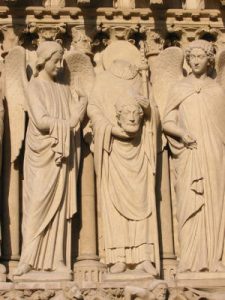
“Execute you,” I said. “But don’t worry. Blasphemy isn’t a crime anymore. You can disagree with someone’s notion of holiness and godliness, or beauty for that matter, without being arrested. In fact, this building doesn’t even belong to the Catholic Church anymore. It belongs to the French State, the government, the people. We should respect that some come here to pray while the people praying should respect us as curious people visiting a historical monument. That doesn’t mean that you can say bad things about a person or a group because of their religion. That’s against the law. Well, you can say them, just not too publicly.”
“You mean inside the church?” asked Claire.
“I mean anywhere, when talking about any religion.”
“See that statue there, the guy with his head in his hands? That’s Saint Denis. He came here to convert the Roman-era Parisians to Christianity in the year 250 and was executed.”
“Why?”
“Because the Romans wanted everyone to go to the temple just as the Christians later on wanted everyone to go to church.”
“How about the Muslims?” asked Susan.
“Muslims—Islam—didn’t exist at the time of the Romans and there were few if any who came to Paris before the French Revolution.”
“Can they visit Notre-Dame?”
“Anyone who wants to can. Anyway, as I was saying, Denis was executed, his head chopped off, then he picked it up and kept on preaching until he finally lay down to down and died about 4 miles north of there.”
“He did not,” said Claire.
“That’s what they say. Do you believe that?”
She looked at her mother. Her mother shook her head. “No,” said the girl.
“Neither do I,” I said. “I not sure even think the bishop of Saint Denis Basilica-Cathedral, where Denis is said to be buried, believes it.”
“How do you know?” said Susan.
“I met him once. A friendly man. I asked him if Catholics are really expected to believe that Denis picked up his head after it’d been chopped off and he said those who want to believe it can believe it but more importantly it shows that it wasn’t the Romans who decided when Denis should die but Denis, as a martyr, himself. Do you think that sculpture’s beautiful?” I asked. “Susan?”
“I like the angels to either side,” she said.
“Claire?”
“I don’t know. Do I have to say?”
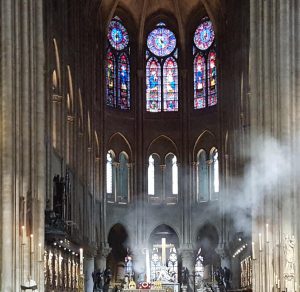
“No. But now you know why it’s there. It’s a story. These are all stories,” I said as we got in line to walk inside the cathedral, “like pages of a book.” It was a slow day, only 10 minutes to get it. I pointed out Jesus in judgment, saints, apostles and sinners, visions of Hell, the Church and the Synagogue, Anne and Joachim, Jesus and Mary. “Lots of this was restored, even created, in the middle of the 1800s, some of it during time of our Civil War.”
“Did slaves build it?” asked Claire.
“No. Most people involved in building it were poor but they weren’t slaves as we once had in the U.S.; they weren’t owned as property. When I mentioned the Civil War I wanted to say that those portions from the middle of the 1800s aren’t really so old in Paris terms. The steeple you saw before, when were at the back of the square, was added then. There was a steeple long before but what’s there now wasn’t designed at Notre-Dame’s inception. The steeple is a part of Notre-Dame’s history but it’s relatively recent if you think back to 1163 when the project was started. It’s part of Notre-Dame’s evolution.”
“Some kids in my class say they don’t believe in evolution.”
“They’re the same kids who would stone you for calling their church ugly,” I said.
“He’s exaggerating,” Susan told Claire. “Don’t scare her,” she said with something less than a smile.
“Are you scared, Claire?”
“There was a school shooting in our state,” she said.
“Now that’s scary.” I said.
“Let’s change the subject,” said Susan.
“We were talking about evolution. How things evolve, how they develop, how they change. One day the original timbers holding up the roof may burn up, or the steeple will topple over, or a bomb will destroy part of the cathedral. What do you think they should do then? What would you want? Rebuild it the way it was or add some modern touches, make the portion that was destroyed different?”
We were near the front of the security line then. I said, “Tell me what you think when we get out.”
There was mass going on, incense in the air, arches meeting keystones overhead. There were chapels, stained glass windows, tombs, rose windows, a model of Notre-Dame built and a model of Notre-Dame under construction, lots of people, an organ, a Peruvian painting, a Chinese painting, restored and unrestored colors.

We exited by Saint Denis holding his head, with an angel to either side.
“So if Notre-Dame were to burn down tomorrow do you think the French should rebuilt it the way you see it today?”
“I’d hope so,” said Susan.
“Claire?”
“I don’t know. It’s interesting the way it is. I like that it’s old. But maybe they can do something exciting with it. Liven it up a little bit.”
“You still think it’s ugly?“
“Ugly enough,” she said.
“Fair enough,” I said. “Still beautiful, Susan?”
“More beautiful now that I’ve been here with my favorite and only daughter.”
“Claire, is there anything you see that you’d call beautiful around here?” I asked.
Claire looked around as Susan and I waited for her eye to latch onto something.
“My mother,” she finally said with such gloopy adolescent irony that you knew she meant it.
© 2019, Gary Lee Kraut
Also see Still Life in Paris, Inspired by Notre-Dame, Our Glorious Ladies of Gothic Architecture, and the author’s site for tours, events and advice.


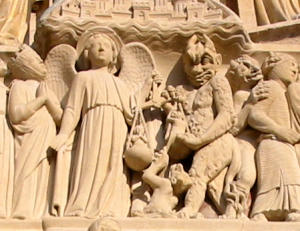
Beautiful, Gary.
You’re a very good teacher!